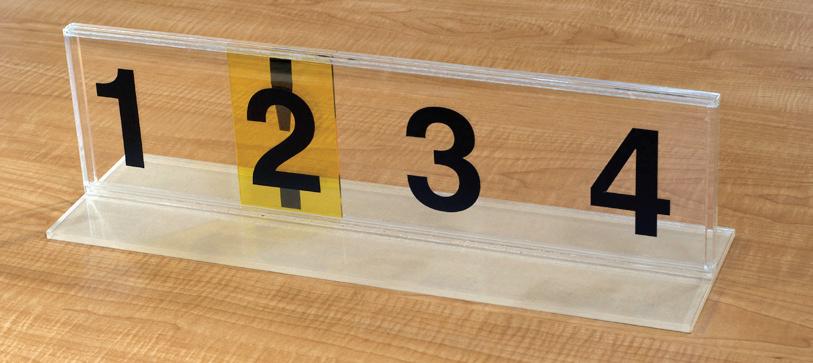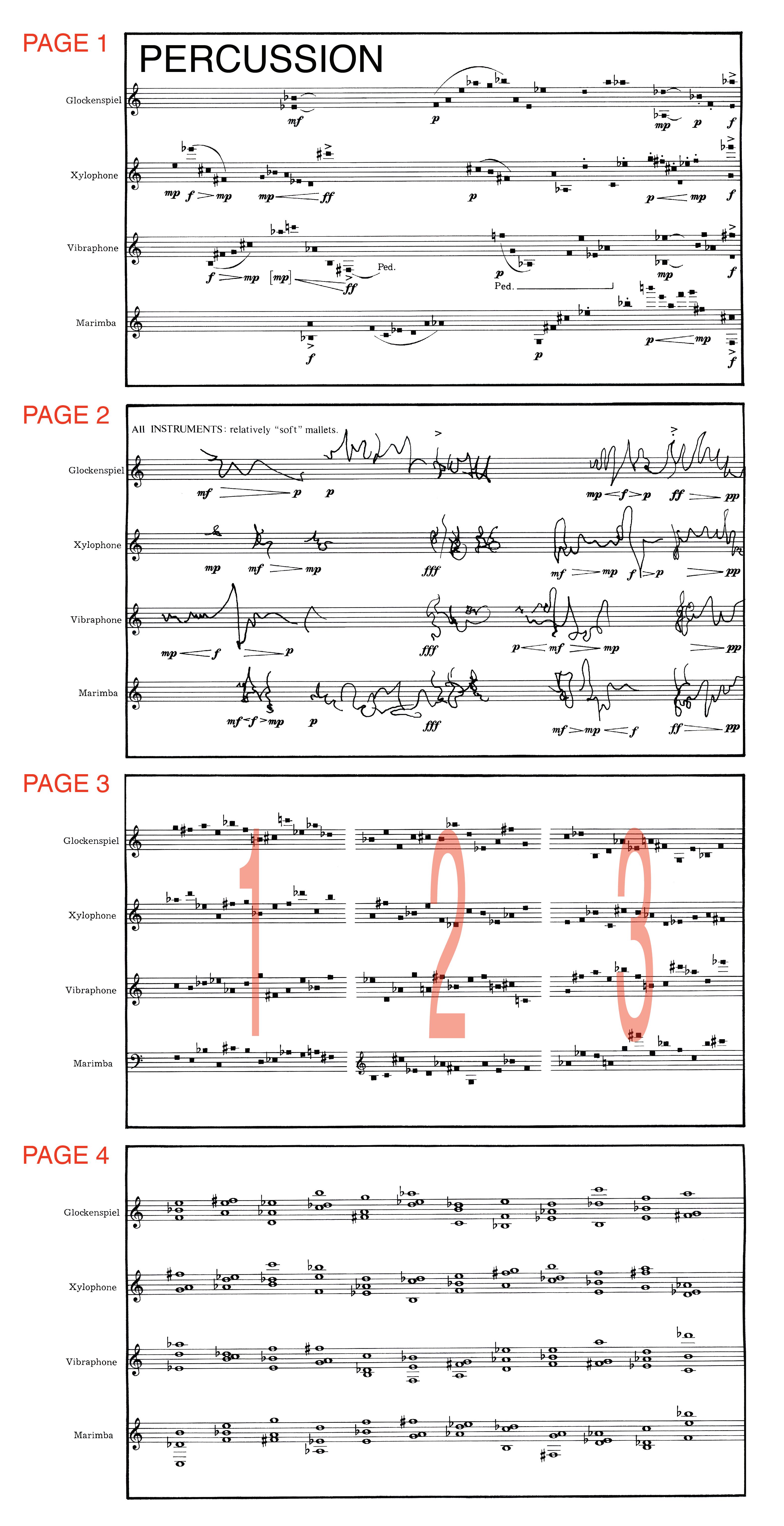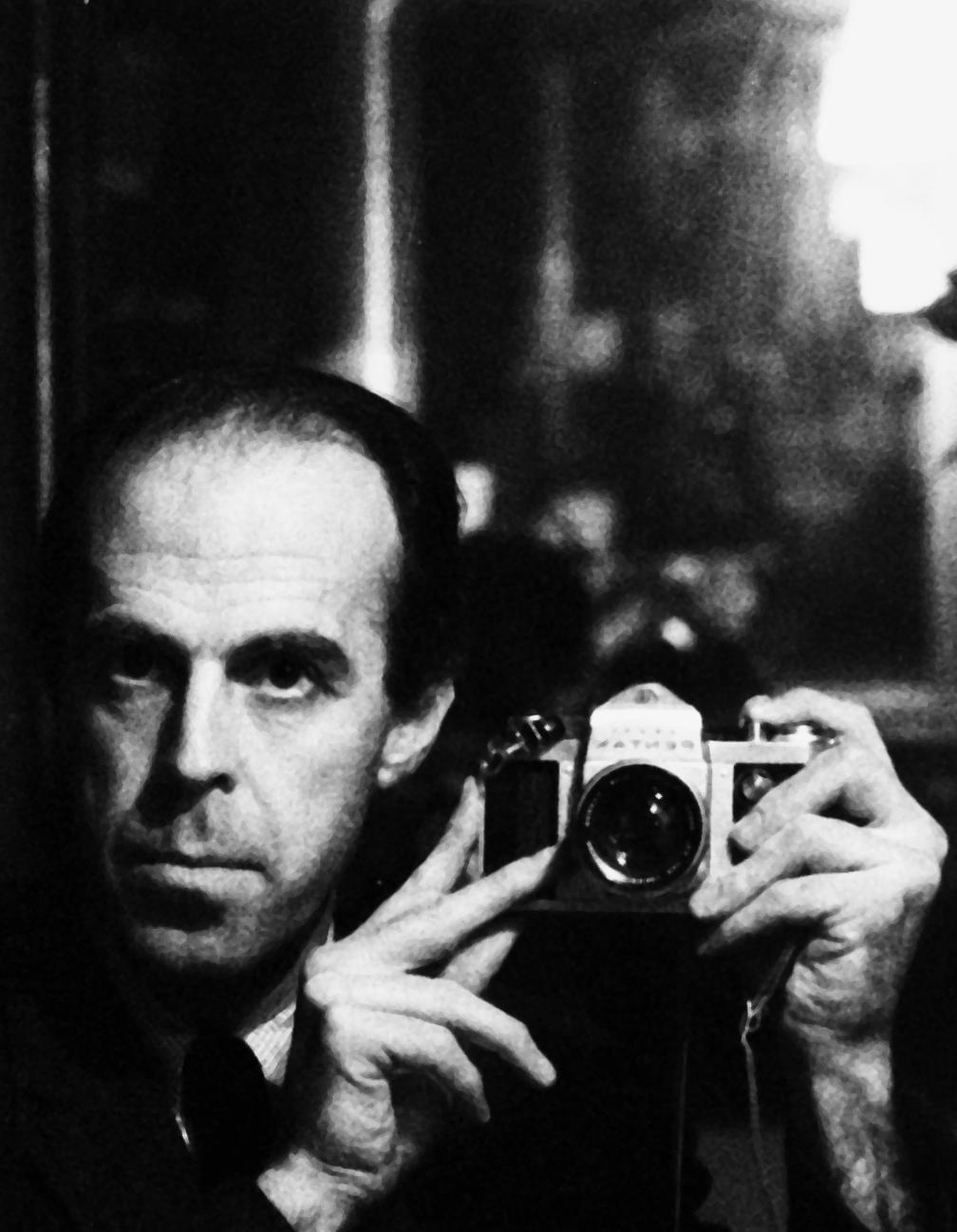BROWN
Sign Sounds for Orchestra Score



Earle Brown
Commissioned by New York State University at Albany for the University-Wide Student Composers Festival at Potsdam, New York, October 1972
Score (transposed)
Instrumentation
Flute
B b Clarinet
Bass Clarinet
Bassoon
Trumpet
Trombone
Glockenspiel
Xylophone
Vibraphone
Marimba
Celeste
Piano
Harp
2 Violins
Viola
Violoncello
Double Bass
Seating on stage:
Strings front left
Woods / Brass front right
Piano mid left
Harp mid center
Celeste mid right
Percussion rear
Duration: variable
The conductor needs an arrow indicator with numbers 1-4 (provided with score) to show the musicians which page to perform from.

SIGN SOUNDS is an “open-form” composition in which the sound-content is written and controlled in “proportional notation.” The final form of each performance of the composed elements will be different according to the musicality and sensibilities of the conductor. There are two pages of sound material for the soloists (celeste, piano, harp) and four pages of sound material for winds, strings, and percussion. See directions for performance for FOLIO (1952-53) and/or AVAILABLE FORMS I and II ( 1961 and 1962 ) or NOVARA (1962) , excerpted below.
The conductor may begin a performance with any event on any page and may proceed from any page to any other page at any time, with or without repetitions or omissions of pages or events, remaining on any page or event as long as he wishes.
The numbers of the score pages to be played from are indicated to the musicians by a movable arrow on a placard displaying the page numbers 1 to 4 — the number and arrow being clearly visible to all members of the group, and the arrow comfortably within reach of the conductor.
It is suggested that the podium be wide enough or that enough music stands be used as a podium for all four score pages to fit next to one another so as to be visible to the conductor at all times during the performance. (In the parts, all of the events on all of the pages are visible to the musicians without the necessity of page turns.)
There is a built-in factor of flexibility in the notation and scoring of this piece because the availability of forms is based on letting go of the idea of metric accuracy. This is achieved through the notational system used in this work. This system, which I have called a “time-notation,” is a development of the work in FOLIO ( 1952 and 1953 ) and most clearly represents sound-relationships in the score as I wish them to exist in performance; independent of a strict pulse or metric system.
It is a “time-notation” (now generally called “proportional notation”) in that the performer’s relationship to the score, and the actual sound in performance, is realized in terms of the performer’s time-sense perception of the relationships defined by the score and not in terms of a rational metric system of additive units. The durations are extended visibly through their complete space-time of sounding and are precise relative to the space-time of the score. It is expected that the performers will observe as closely as possible the “apparent” relationships of sound and silence but act without hesitation on the basis of their perceptions.
It must be understood that the performance is not expected to be a precise translation of the spatial relationships but a relative and more spontaneous realization through the involvement of the performers’ subtly changing perceptions of the spatial relationships. The resulting flexibility and natural deviations from the precise indications in the score are acceptable and in fact integral to the nature of the work. The result is the accurate expression of the actions of people when accuracy is not demanded but “conditioned” as a function within a human process.
The conducting technique is basically one of cueing ; the notation precludes the necessity and function of “beat” in the usual sense (although the conductor does indicate the relative tempo). The page which contains the event to be played is indicated by the arrow, as previously explained. The number of the event to be performed is indicated by the left hand of the conductor — one to five fingers. A conventional (right-hand) down-beat initiates the activity. The relative speed and dynamic intensity with which an event is to be performed is implied by the speed and largeness of the down-beat as given with the right hand. Nearly all of the events in the score have been assigned dynamic values. These are acoustically accurate in terms of instrumental and ensemble sonority and balance and must be respected as written, although the conductor may “over-ride” the indicated dynamic values and raise or lower the over-all loudness.
The conception of the work is that the score presents specific material having different characteristics, and that this material is subject to many inherent modifications, such as modifications of combinations (event plus event), sequences, dynamics, and tempos, spontaneously created during the performance. All events are always prepared by a left-hand signal and initiated by a down-beat from the conductor; the size and rapidity of the down-beat implies the loudness and speed with which the event is to be performed. The conductor must, as with any notation, insist on accurately articulated relationships from the rhythmic “shape” of phrase and pitch sequences in this work.
The right hand of the conductor may indicate the entire section to play or, if pointing to one or more individuals, that they perform their material as soloists out of the ensemble.
The conductor may stop or start an event at any point creating fragments and “bursts” of sound. The conductor may introduce a fermata at any point. The two hands of the conductor, in addition to above, are used in the traditional way to control loudness, tempo, changes of both, and to communicate conditions of style, nuance and expressivity.
SPECIFIC INSTRUCTIONS for the 1972 performance can be found in correspondence between Earle Brown and the conductor Dan Asia, dated 1972.
PAGES:
STRINGS , W INDS , BRASS AND P ERCUSSION :
PAGES 1 & 2
Pages 1 are highly articulate, though in “proportional notation.” Suggest that each musician learn his or her parts as if solos. Pages 1 and 2 may be conducted as full ensembles or “taken apart” and done as individual solos, duets, trios, etc. Rehearse spacing (proportional) and sound-color and dynamics very carefully. May be conducted at all tempi! Rehearse same material very fast to very slow. Proportional notation (spacing) must be respected at all tempi. Overall dynamics may be raised or lowered by the conductor as in the raising and lowering of tempo. Get accuracy but be flexible in vertical synchronicity. Proportional notation is pro rhythmic variations — performance to performance.
EVENTS:
W INDS AND B RASS
Page 1 . Articulate fermata last notes.
Page 2 . Sparse textures.
Page 3 . Three pointillistic events. L. H. 1 + 2+3 followed by one down-beat means play through entire 1, 2, 3 line. Conductor may decide to make entire line repeat until stopped.
Page 4 . Six-note chords. Sustain each until conductor stops the continuity or changes to next chord by down-beat directly to wind section. (On long sustain, breathe when necessary, as undramatically as possible and return to your note.) Size of down-beat indicates relative loudness. Watch for changes of tempo, loudness, interruptions of given continuity and changes of page and left-hand event-signals!
STRINGS
Pages 1, 2 & 3 . Same instructions as WINDS
Page 4 . L. H. 1 = 5- note chords (see page 4 winds). L. H. 2 = Harmonics. Each instrument durations free (not controlled by conductor) ||: :|| repeat if wished. L. H. 3 = “Wrong” side of bridge. All 4 strings of instruments random tremolo.
P ERCUSSION
Page 1 . Articulate.
Page 2 . Graphic notation with textures and dynamics. Two sectionally cued points: and . Be very accurate with entrances and dynamics.


Page 3 . As with WINDS and STRINGS.
Page 4 . Three-note chords for each instrument. Each vertical chord in rhythmic continuity may be synchronized by conductor or started by downbeat from conductor and free durations and chord changes by percussionists.
Page 1 . Events 1 + 2 + 3 (+ 4 in piano) may be individual ( only L. H. 1 or 2 or 3 or 4 ) or L. H. 1-2-3(4) in sequence followed by a single downbeat = entire line as scored (not synchronized by conductor). The three soloists may be overlapped in any way. Indicate directly to each soloist , stops, starts, increase of speed and/or loudness. Any combination — with or without WINDS, STRINGS, and/or PERCUSSION.
Page 2 Event 1 : “open-hand” clusters (follow rhythm and range) repeating :||.
Events 2 : articulate figures. Events 3 : (celeste- points :||) (piano points :||) (harp, same).
remember that you can create many overlapping events.
For example:
Start percussion page 4 (independent changes, repeating, pp , direct to them cue). Move arrow to page 3 , cue strings (points repeating); percussion continues page 4 until otherwise changed. Move arrow to page 2 , cue celeste, piano, and harp (clusters repeating). Move arrow to page 1 , cue strings (articulate detail, non-repeating until re-cue). Move arrow to page 4 , cue winds (conduct chord sequence in strong, rhythmic changes).
At this point, percussion, strings, and soloists are “looping” (dense texture). Strings are very articulate and come to a concluding fermata. You can re-start section or any combination of solos. Winds have a conducted chord sequence.
ENTIRE ORCHESTRA IS ACTIVE: to initiate or change events, conductor must have page indicator ( 1, 2, 3, 4 ) and left-hand indications absolutely accurate and clear to all. The sections are geographically seated. Conductor must indicate clearly if he wants the entire section or a single solo instrument.
be physically articulate





Earle Brown was born in 1926 in Lunenburg, Massachusetts, and in spirit remained a New Englander throughout his life. A major force in contemporary music and a leading composer of the American avantgarde since the 1950s, he was associated with the experimental composers John Cage, Morton Feldman and Christian Wolff, who – together with Brown – came to be known as members of the New York School. Brown died in 2002 at his home in Rye, New York.
Earle Brown wurde 1926 in Lunenburg, Massachusetts, geboren und blieb im Geist ein Leben lang Neuengländer. Ab den 1950er Jahren war er eine treibende Kraft in der zeitgenössischen Musik und einer der führenden Komponisten der amerikanischen Avantgarde. Enge Verbindung unterhielt er zu den experimentellen Komponisten John Cage, Morton Feldman und Christian Wolff, mit denen gemeinsam er später der sogenannten New York School zugerechnet wurde. Brown starb 2002 in seinem Haus in Rye, New York.